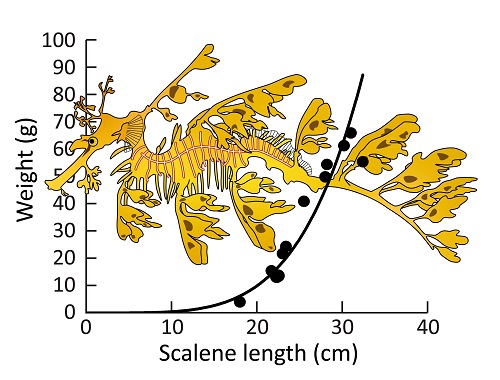
Common seadragon. Photo by Melanie Warren.
Despite their odd shape, which makes them resemble a tuft of seaweed, common and leafy seadragons grow in the same fashion as other bony fish, new research has found.
In a paper published in the journal Fishes, an international team of researchers estimate, for the first time, the length-weight relationships (LWR) of the two species. LWR allow computing the weight from fish’s length, which is a useful measure, for example, for estimating the biomass of certain species or comparing their productivity.
“As seadragons are extremely fragile and protected in southern Australia – the only place where they occur naturally – their study has been limited and basic information on their biology is still lacking, even on something as basic as their length-weight relationships,” said Dr. Daniel Pauly, lead author of the study and principal investigator of the Sea Around Us initiative at UBC’s Institute for the Oceans and Fisheries.

Graphical abstract by Elaine Chu.
To express the length of seadragons, which have a crooked shape, the group defined a new type of length which they called ‘scalene length’ because it refers to the longest side of a scalene triangle, whose other sides are formed by the head (including the snout) and the (gently) stretched body and tail.
The scalene lengths, weights and ages of 40 specimens of common and 15 of leafy seadragons kept at the Scripps Institution of Oceanography’s Birch Aquarium, in San Diego, were then used to estimate their LWR and growth, while preserved specimens from the Australian Museum in Sydney were used for other measurements.
“By estimating their LWR, we were able to derive a number of important biological traits of seadragons and compare them with those of other bony fishes,” Pauly said. “Notably, we documented that the growth of both common and leafy seadragons is relatively slow compared to that of other fishes. This is not surprising because the growth performance of fish is closely related to the size of their gills and it is known that fishes in their family – the syngnathids, same as seahorses – lack gills capable of providing their owner with a high oxygen supply.”
Using scalene lengths also allowed the researchers to compare common and leafy seadragons. They noted that the latter tends to weigh more than the former, but that this has nothing to do with the extravagant, leaf-like appendages that leafy seadragons exhibit, but rather with the fact that their bodies are stouter.
“Moreover, the appendages of seadragons appear to consist of tissues that are metabolically inert,” Melanie Warren, co-author of the paper and a graduate student with the Sea Around Us, said. “This corroborates the hypothesis that, while obviously requiring oxygen for the initial synthesis of their tissues, the appendages of both species of seadragon do not require much oxygen for their maintenance.”
The paper “Length-weight relationships and growth parameters of common and leafy seadragons (Syngnathidae) from a public aquarium” appeared in Fishes 7(77) https://doi.org/10.3390/fishes7020077

